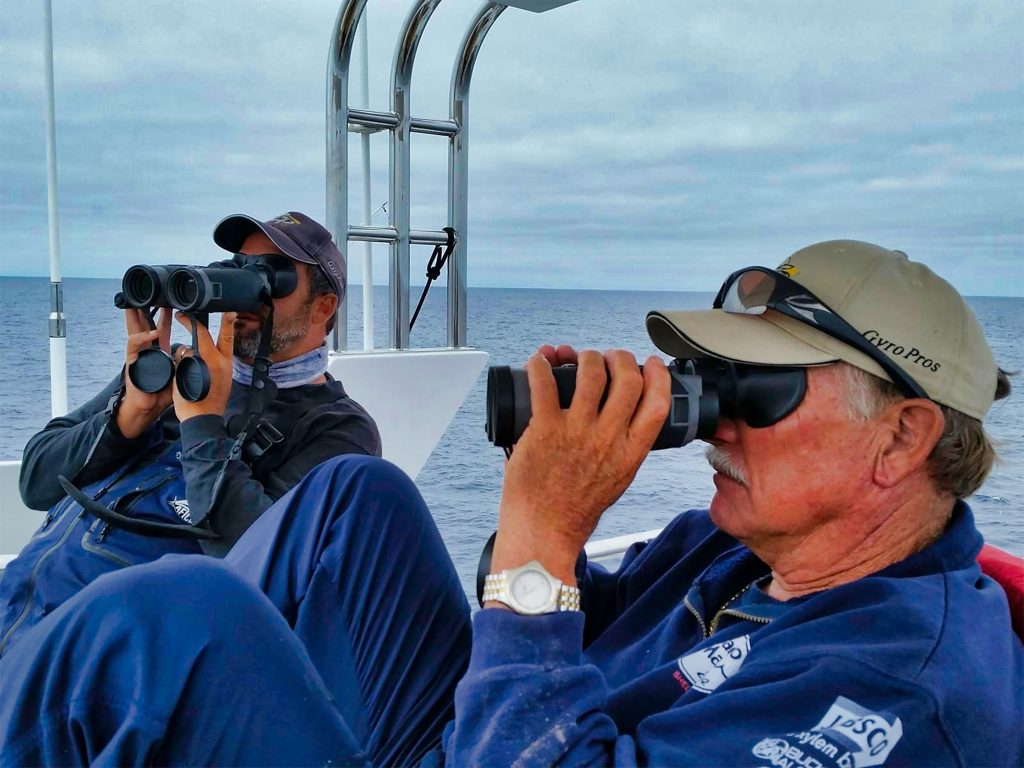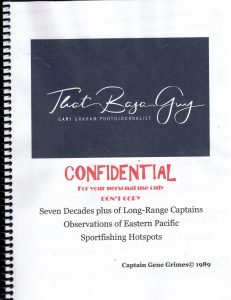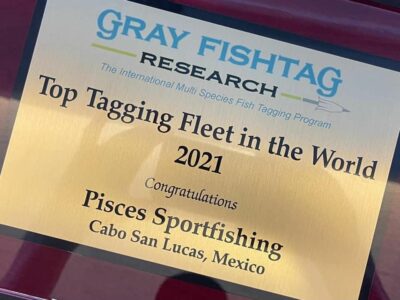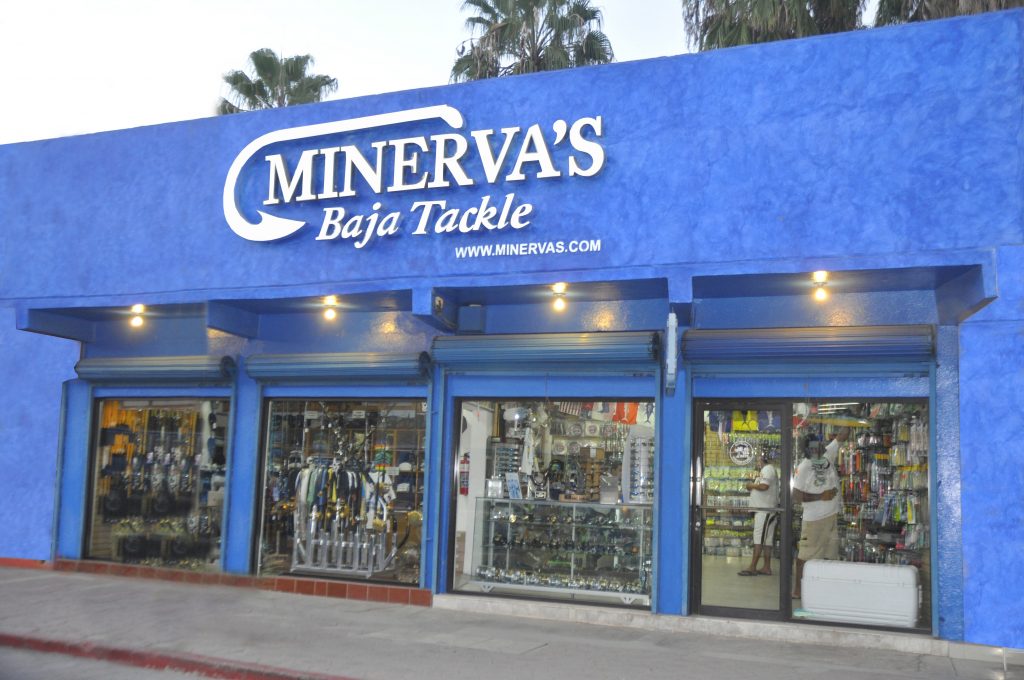A bank, or seamount, is a shallow part of the ocean floor that rises higher than the surrounding area. It’s like the top of an underwater hill. Usually formed by volcanic activity, seamounts are some of the most common marine ecosystems in the world. Interactions between seamounts and underwater currents, plus their elevated position in the water, attract plankton, coral, fish and marine mammals alike.
For decades, the banks around Land End or El Arco, a recognizable rock formation at the tip of the Baja California peninsula, have been training grounds or playgrounds, or better yet, fields of dreams, for local and visiting anglers, captains and crews. They offer ideal venues for fine-tuning innovative fishing techniques regardless of style or for just having fun.
These seamounts hold an unparalleled assortment of gamefish common to the area, all within a fifty-mile radius of Cabo San Lucas. As such, they entice enthusiastic sportfishermen year-round and from around the globe to Cabo San Lucas, which is the undisputed Marlin Capital of the World.
Baja Billfish and More
Billfish favor these fertile waters at the peninsula tip, where the Sea of Cortez and the Pacific Ocean merge. They are often found close to shore even before you reach the targeted banks, where their large numbers can result in multiple releases. Although anglers often hook into gigantic blue and black marlin and perhaps spot a finning swordfish milling about that they can toss a live bait to, in these prolific fishing grounds, the volume of striped marlin steals the show.
Although billfish are the rockstars, there is a long list of other species that seasonally appear offshore throughout the region. This includes trophy-sized dorado, yellowfin and wahoo, to name a few. Any of the above can show up in the trolling spread at any moment, and fortunately, many of the same lures that are productive for the stripers attract the other species as well. In addition, keeping a couple of live bait rigged and ready swimming in the bait tank to drop back when an unexpected fish suddenly appears in the wake is a must.
Inshore, the fascinating assortment of gamefish on the surface includes roosterfish, a variety of different jacks, dorado, pompano, sierra, giant needlefish, small yellowfin and both white and black skipjack. Deeper down in the water column, yellowtail, amberjack, grouper, cabrilla, pargo, dog snapper and a host of other fish will have anglers reaching for their Fish ID Book.

The Sea of Cortez and the Pacific Ocean
All banks featured and marked on the Google Earth Chart are within reach of the marinas at Cabo San Lucas and Puerto Los Cabos in San Jose del Cabo. However, boats based out of the San Jose del Cabo Marina are closer to the Inner and Outer Gordo Bank, Santa Maria Canyon, Cabrillo Seamount, 1150 Bank and the north Vinorama Canyon. In addition, anglers should be aware that the Finger Bank on the Pacific side is approximately 75 miles from the San Jose del Cabo Marina.
Cabo San Lucas, centrally perched at the Baja Peninsula Land End near the point where the Pacific and the Sea of Cortez collide, is ideal to find billfish and other species passing between the two bodies of water. On the Pacific side, there is the 45 Spot and Cabo Falso (Old Lighthouse area), San Jaime Bank, Golden Gate Bank and farther north, the fabled Finger Bank. Within the relatively small 50-mile radius of Land End, the nine banks share the unique similarity of being reasonably close in distance. They offer a similar species list at each location with few exceptions. One of the advantages of having different banks from which to choose is if one doesn’t produce ”sea temperature change, off-color water or the fish seem to be down” other seamounts might prove more productive.

Where To Fish and How
Assuming your crew includes a spotter or two on the bridge using stabilized binoculars during the run to another bank, there is a possibility you may find a school of porpoise traveling with yellowfin or a finning swordy might pop along the way! It is not unusual to have that happen or for striped marlin to be tailing on the surface between the banks. Often, it just turns out to be a time-of-day deal when they show at high slack tide in one area and low slack in a different zone. Another consideration is what fish you are targeting. If it happens to be billfish (sail, striped, black or blue), and nothing is happening, consider changing tactics a tad with the hope of enticing yellowfin tuna, dorado or wahoo to bite. Maybe an adjustment in trolling speed, either faster or slower, or switching some of the lures, adding a dredge or a deep-running Marauder-style wahoo lure rigged with wire to the pattern.

Braving the Banks of Baja
The banks surrounding the tip of Baja are a paradox that must be understood for fishing to be successful. Depths, currents, species and techniques are all part of the equation before deciding on the direction and species. Techniques to catch the fish are limited only by the imagination of the captain and crew. They can include lures, live or dead bait, sardine, sardina (flatiron herring), mackerel, ballyhoo, flying fish, goggle-eyes, mullet, squid and other smaller fish that end up in the bait tank. The presentation can also include outriggers, downriggers, dredges, squid chains and kites.
Five decades ago, Gene Grimes, a legendary San Diego Captain who had fished worldwide, gave me a copy of a handwritten, telephone-directory-sized book with notes, sketches and observations of many well-known yachts and long-range captains dating back to the 1950s. That info, combined with knowledge from numerous Cabo fleet captains and local captains who fished the banks for decades, was the source of the information contained therein. As I was wrapping up this feature in mid-January, Rebecca Ehrenberg observed recently that, underscoring Los Cabos’ title as the Marlin Capital of the World, their fleet had released 1,376 billfish in the first two weeks of 2022, an incredible start to another extraordinary year.

Nine Top Cabo San Lucas Fishing Banks
The Finger Bank
GPS Coordinates Degree, Minutes, Seconds: 23°1747.06³N, 110°3244.91³W
This area, located 50 miles away from the Cabo San Lucas Marina Harbor, is off the coast of Todos Santos. In the early months of the year, striped marlin and sailfish pass through as they migrate. Their migratory path is either up into the Sea of Cortez, or across to Mexico Mainland, continuing south along the east coast to South America, before heading west out into the eastern Pacific. If conditions are right, boats in the area can spot huge schools of sardine balled up with birds hovering overhead. The feeding stripers and other pelagics force the schools of baitfish to remain on the surface until they have eaten the last bait and all that left are the scales. This scene is like the action described at Magdalena Bay in the late fall and early winter, where anglers often rack up their personal best in terms of numbers of stripers caught and released, sometimes reaching double or triple-digit scores daily. However, even with the phenomenal striper action found during different periods of the year, the distance limits the number of boats that can travel that far regardless of the bite. Depending on the conditions, cow-sized yellowfin weighing up to 300 pounds show throughout the year, along with dorado and wahoo.
Golden Gate Bank
GPS Coordinates Degree, Minutes, Seconds: 23° 125.11N, 110°1753.9W
The Golden Gate Bank is a flat coral bottom bank that runs north and south. 60 to 65 fathoms is close to the high spot that often serves as a go-to spot when the Finger Bank has rolled over and turned off-color and cold. This bank is located 15 miles north of El Arco at Land End outside the Cabo San Lucas Marina on the opposite end of the Tinaje Trough, which extends down to San Jaime Bank. The consistently warmer water currents filled with plankton attract various baitfish in an extraordinary food chain that is irresistible to a vast array of gamefish. This begins with billfish, which are joined by dorado, wahoo and huge yellowfin tuna, depending on the time of year.
San Jaime Bank
GPS Coordinates Degree, Minutes, Seconds: 22°5150.33N, 110°155.48W
San Jaime Bank is at the southern end of the Tinaje Trough. The deepest part is approximately 3,500 feet and features underwater caves and mountains, with a 600-feet-deep plateau. Three seamounts extend from the bottom to a height of 150 feet below the sea surface, providing an ideal habitat for the entire food chain to gather from plankton to gamefish.
45 Spot
GPS Coordinates Degree, Minutes, Seconds: 22°4940.40N, 110°0031.97W
Playa El Faro Viejo, or The Old Lighthouse, is located on top of a sand dune where the geographical limit of the two coasts, the Pacific Ocean and the Gulf of California, were established. In addition, it is a landmark for another promising fishing site only two miles offshore and a short distance from the Cabo Marina. The 45 Spot is a rise at the end of a 600-foot-deep ledge of the Cardonal Canyon. It is only six miles to the west of the famous arch and produces some great fishing. Unfortunately, the Cardonal Canyon, a short distance to the west of the 45 Spot, is where the ocean bottom quickly drops to 3,000-feet depth.
Santa Maria Canyon
GPS Coordinates Degree, Minutes, Seconds: 22º 51² 59³N, 109º 45² 00.00³W
This local favorite lies approximately nine miles between the 1150 Bank and the inner and outer Gordo Banks. The area can become crowded during the high season with many of the other Baja gamefish common, such as schools of yellowfin tuna, dorado, wahoo and many different species of skipjack, all of which are favored by local and international anglers alike.
1150 Bank
GPS Coordinates Degree, Minutes, Seconds: 22°4436.21N, 109°2630.57W
The 1150 Bank is located slightly to the east of Santa Maria Canyon. This fishing haven is farther off the coast and almost between the San Lucas and San Jose marinas, approximately 20 to 25 miles out. The 1150 Bank is a terrific spot for marlin and tuna fishing, reflecting the characteristics of the Sea of Cortez and Pacific Ocean mixed.
Cabrillo Seamount
GPS Coordinates Degree, Minutes, Seconds: 22º 49² 59³N, 109º 16²0.00³W
Located 45 miles east of the 95 Spot, the Cabrillo Seamount rises 3,000 feet from a rock bottom twice that depth. Although it some distance farther than other angling spots, Cabrillo Seamount presents an opportunity to catch a variety of billfish and other pelagics.
Inner & Outer Gordo Banks
GPS Coordinates Inner Degree, Minutes, Seconds: 23° 10.01N, 109º 31² 00.01³W
GPS Coordinates Outer Degree, Minutes, Seconds: 23º 01² 00.01³N, 109º 28²00.01³W
The Inner Gordo Bank is within easy reach of pangas fishing out of Puerto Los Cabos, while the Outer Gordo Bank is farther off the coast”approximately ten miles. The best time to fish Gordo Banks is from April to November, when the water temperature, clarity, currents and bait supplies are at their best. The currents hit the rock formations in the area, creating upwellings that bring nutrients to the surface. The nutrient-rich waters attract baitfish, which draw the attention of pelagics. However, fishing remains possible throughout winter because the banks are shielded from the north winter winds by the Sierra Madre Mountain range.
Vinorama Canyon
GPS Coordinates Degree, Minutes, Seconds: 23º 14² 06.11³N, 109º 24² 05.72³W
Vinorama Canyon is northeast of Gordo Banks, and because of its year-round angling action from bottom fishing to trolling, it is another popular location. This site features a bottom filled with ledges and rocks that attract a variety of fish. The beginning of the year is excellent for yellowtail fishing, while the second half of the year is ideal for dorado fishing. In addition, anglers enjoy tuna fishing year-round.
Los Cabos Marinas and Boatyards

Igy Marina Cabo San Lucas
Tel: +52-624-173-9140
Email: [email protected]
For over 13 years, Darren Carey has been the Mexico Regional Director and General Manager for this marina. Developed in a natural basin, the IGY Marina Cabo San Lucas is one of the largest in Baja. A wide Malecón, lined with outdoor restaurants, shops and a small shopping center, surrounds the 380-slip Marina, which welcomes yachts up to 375-feet. The Marina fuel dock boasts a high-speed pump that delivers quality-controlled fuel, and its desalinization plant supplies the entire facility with up to 40,000 gallons of potable water daily. In addition, there is a fleet of more than 100 charter vessels available for sportfishing.
Marina Del Rey
Tel: +52-624-164-8646
US Tel: +1-619-259-6902
Email: [email protected]
Marina Del Rey reopened in 2016 with new docks, an on-site fuel station and a new layout consisting of slips for boats up to 130-feet in the private boat area. There also a commercial section located across the water that can accommodate boats up to 60-feet. In addition, the Pemex fuel station can fuel vessels up to 220 feet in length. Manager Brian Hopper, an American/Mexican citizen, holds a boat captain license and is a qualified boatyard manager.
Cabo Yacht Center
Tel: +52-624-143-3020
US Tel: +1-619-819-8779
Email: [email protected]
Cabo Yacht Center is the only boatyard near both IGY Marina Cabo San Lucas and Marina Del Rey. The Center offers maintenance, repairs and custom work. In addition to providing yard work and dockside services, they also offer boatbuilding and fabrication.
Puerto Las Cabas Marina
Tel: +52-624-184-0566
Email: [email protected]
Puerto Los Cabos is a 2,000-acre, masterplanned, mixed-use resort community with gated residential neighborhoods, hotels and golf courses. The world-class marina offers 230-slips and can accommodate megayachts up to 250-feet. There are concierge services and a maintenance yard.
Minerva’s Baja Tackle
Tel: +52-624-143-1282 or +52-624-143-2766
US Tel: +1-909-266-3154 US
Toll Free: +1-888-480-7826
Email: [email protected]
Located a few blocks from IGY Cabo San Lucas Marina, this full-service tackle shop carries an extensive selection of brand-name rods, reels, gear and more for whatever type of fishing is planned: inshore, offshore, top-water or deep jigging. Reel service, rod repair, line replacement, rigging and general tackle maintenance are also available.

About the Author
Award-winning photojournalist and speaker Gary Graham has published 2,000-plus weekly editions of his Baja California fishing reports, two DIY books on saltwater fly-fishing in Baja and feature articles in several West and East Coast publications, earning his nickname That Baja Guy.”













